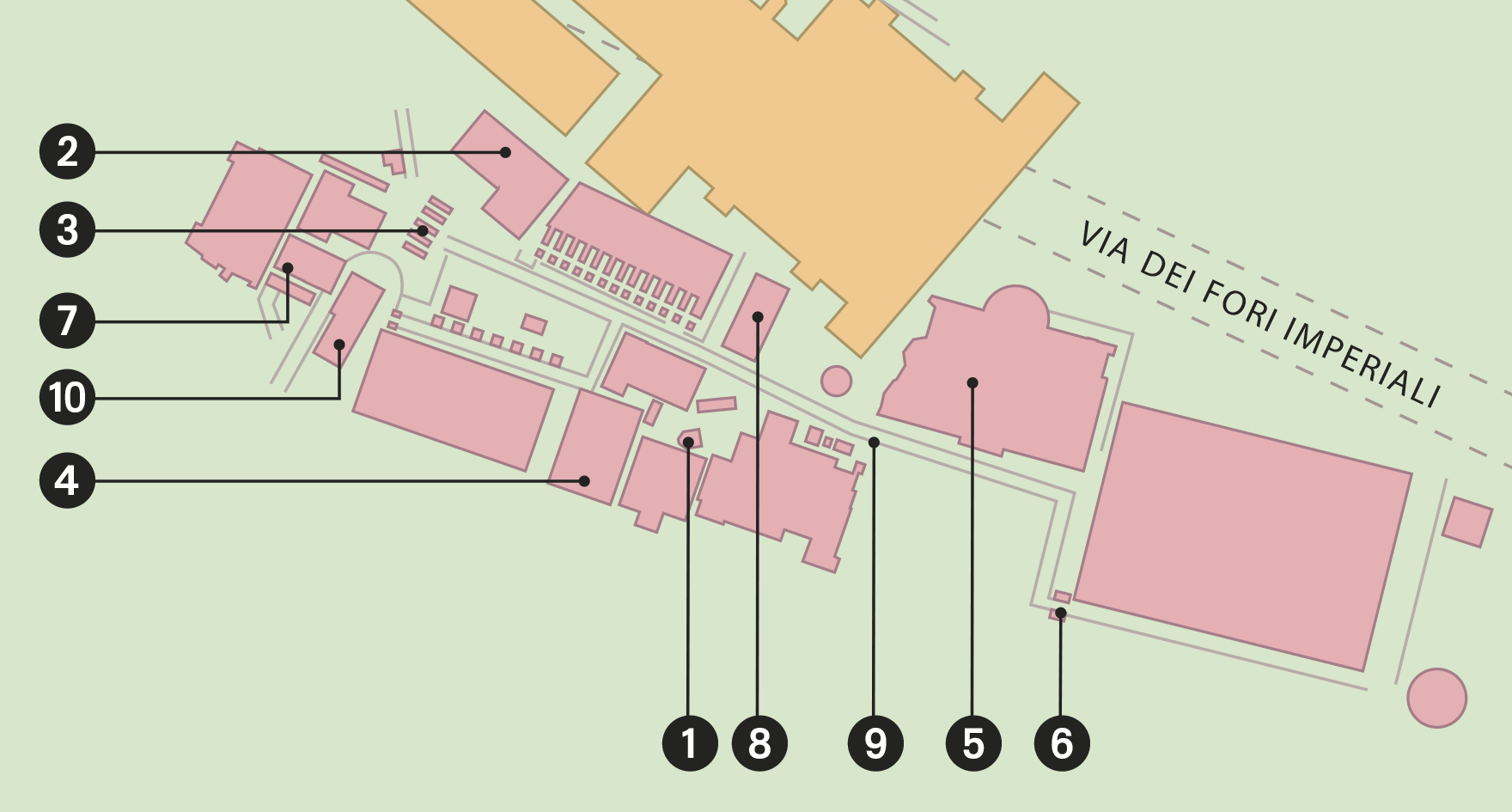
ROMAN FORUM
Gazing on the picturesque ruins today, one would hardly guess that the Forum was the symbol of civic pride for 1,000 years. Its beginning, more than 3,000 years ago, was as a cemetery for the village on Palatine Hill. When the marshy land was drained in the 6th century BCE, the Forum took on a more central role. It was at its most elegant starting with the reign of Augustus, who is said to have turned the city from brick to marble.
NEED TO KNOW
![]() Via dei Fori Imperiali • 06 3996 7700 • Open Feb 16–Mar 15: 8:30am–5pm daily; Mar 16–31: 8:30am–5:30pm daily; Apr–Aug: 8:30am–7:15pm daily; Sep: 8:30am–7pm daily; Oct: 8:30am–6:30pm daily; Nov 1–Feb 15: 8:30am–4:30pm daily; closed Jan 1, Dec 25 • Adm $14 (includes Palatine & Colosseum; valid for 48 hr); free for under 18; free for all first Sun of the month
Via dei Fori Imperiali • 06 3996 7700 • Open Feb 16–Mar 15: 8:30am–5pm daily; Mar 16–31: 8:30am–5:30pm daily; Apr–Aug: 8:30am–7:15pm daily; Sep: 8:30am–7pm daily; Oct: 8:30am–6:30pm daily; Nov 1–Feb 15: 8:30am–4:30pm daily; closed Jan 1, Dec 25 • Adm $14 (includes Palatine & Colosseum; valid for 48 hr); free for under 18; free for all first Sun of the month
- The only option in the immediate area for drinks and snacks is one of the mobile refreshment vendors. For something more substantial, there are plenty of cafés and restaurants on Via Cavour.
- In summer, it’s best to visit the Forum either early or late in the day, to avoid the intense heat.
Forum Guide
You can access the Forum from Via dei Fori Imperiali. However, for a great view of the whole site, enter from one of the high points at either end. From the northwest end, begin on the Capitoline (to the right and behind the huge, white Victor Emmanuel Monument) and take the stairs down from Largo Romolo e Remo. From the southeast end, start at the Colosseum and climb the small hill just to the northwest. Enter by the Arch of Titus, which is also near the main entry gate to the Palatine.

Original Plan of the Roman Forum
1. Temple of Vesta and House of the Vestal Virgins
A graceful round temple and its adjacent palace were the center for one of the city’s most revered cults. Noble priestesses tended the sacred flame and enjoyed the greatest privileges.
2. Curia
The 3rd-century CE Senate retains its original polychrome inlaid floor, its risers where the 300 senators sat in deliberation, and the speaker’s platform. For 2nd-century views of the Forum, examine the large marble reliefs, showing Emperor Trajan’s good works.
3. Arch of Septimius Severus
This well-preserved triumphal arch celebrates the emperor’s Middle Eastern victories. It was erected in 203 CE by his sons, Geta and Caracalla, then co-emperors.
4. Temple of Castor and Pollux
Three Corinthian columns remain of this temple to the Dioscuri—twin brothers of Helen of Troy and sons of Jupiter and Leda. It marked the spot where they miraculously appeared in 499 BCE to announce a crucial Roman victory.

5. Basilica of Maxentius and Constantine
Three vast, coffered barrel vaults proclaim the Forum’s largest structure, built around 315 CE and used as the legal and financial center of the Empire.
6. Arch of Titus
The oldest extant arch in Rome was built in 81 CE by Emperor Domitian to honor his brother, Titus, and his father, Vespasian, for putting down the Jewish Revolt. Reliefs show the sacking of Jerusalem’s Holy of Holies and sacred objects, such as a golden menorah, being taken.
7. Temple of Vespasian
Until 18th-century excavations, these graceful columns (79 CE) from a temple to the former emperor stood mostly buried beneath centuries of detritus.
8. Temple of Antoninus and Faustina
Dedicated by Antoninus Pius in 41 CE to his deified wife Faustina, this is one of the best-preserved temples. With its Baroque-style top-knot, it is also one of the oddest. Note the carvings of griffins along the side frieze.

9. Via Sacra
Paved with broad, flat, black basalt stones, Rome’s oldest road wound from the Arch of Titus through the Forum and up to the Capitoline. Triumphal processions were staged here, but it degenerated into a hangout for gossips, pick-pockets, and other idlers.
10. Temple of Saturn
Eight gray-and-red Ionic columns constitute what’s left of this temple (also the state treasury) to the ruler of agriculture and of a mythic “Golden Age.” Saturnalia, celebrated each December, was very similar to modern-day Christmas.

